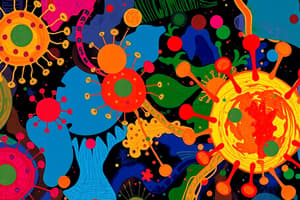Podcast
Questions and Answers
Which cytokine family is primarily associated with promoting neutrophil accumulation and activation?
Which cytokine family is primarily associated with promoting neutrophil accumulation and activation?
Which of the following cytokines is NOT part of the Class 1 (hematopoietin) cytokine family?
Which of the following cytokines is NOT part of the Class 1 (hematopoietin) cytokine family?
Which family of cytokines includes proteins that may induce apoptotic death?
Which family of cytokines includes proteins that may induce apoptotic death?
What is a common functional characteristic shared by all chemokines?
What is a common functional characteristic shared by all chemokines?
Signup and view all the answers
Which cytokine family is considered to have the greatest functional diversity?
Which cytokine family is considered to have the greatest functional diversity?
Signup and view all the answers
What is the primary role of Toll-like receptors (TLRs) in the immune response?
What is the primary role of Toll-like receptors (TLRs) in the immune response?
Signup and view all the answers
Which statement accurately describes the expression of receptors for Pathogen Associated Molecular Patterns (PAMPs)?
Which statement accurately describes the expression of receptors for Pathogen Associated Molecular Patterns (PAMPs)?
Signup and view all the answers
What is the significance of CD4 and CD28 receptor-associated molecules?
What is the significance of CD4 and CD28 receptor-associated molecules?
Signup and view all the answers
Which of the following correctly characterizes Pattern Recognition Receptors (PRRs)?
Which of the following correctly characterizes Pattern Recognition Receptors (PRRs)?
Signup and view all the answers
What types of motifs do PAMPs represent for the immune system?
What types of motifs do PAMPs represent for the immune system?
Signup and view all the answers
Which of the following receptors is primarily responsible for recognizing carbohydrate components of fungi and mycobacteria?
Which of the following receptors is primarily responsible for recognizing carbohydrate components of fungi and mycobacteria?
Signup and view all the answers
What is a common outcome of the binding of a cytokine to its receptor?
What is a common outcome of the binding of a cytokine to its receptor?
Signup and view all the answers
In which type of action do cytokines influence cells at a distance through the bloodstream?
In which type of action do cytokines influence cells at a distance through the bloodstream?
Signup and view all the answers
Which cytokine action describes the scenario when two cytokines combine to create an effect greater than the sum of their parts?
Which cytokine action describes the scenario when two cytokines combine to create an effect greater than the sum of their parts?
Signup and view all the answers
Which receptor is activated by fragments of extracellular bacteria's cell wall peptidoglycans?
Which receptor is activated by fragments of extracellular bacteria's cell wall peptidoglycans?
Signup and view all the answers
Which family of cytokines does IL-1β belong to?
Which family of cytokines does IL-1β belong to?
Signup and view all the answers
What is the main role of retinoic acid inducible gene-I (RIG-I)-like receptor?
What is the main role of retinoic acid inducible gene-I (RIG-I)-like receptor?
Signup and view all the answers
Which cytokine signaling result inhibits the effect of another cytokine?
Which cytokine signaling result inhibits the effect of another cytokine?
Signup and view all the answers
Which of the following actions allows cytokines to influence the cell that produced them?
Which of the following actions allows cytokines to influence the cell that produced them?
Signup and view all the answers
Which receptor is known for recognizing viral and bacterial DNAs?
Which receptor is known for recognizing viral and bacterial DNAs?
Signup and view all the answers
What role does IL-1 play in immune responses?
What role does IL-1 play in immune responses?
Signup and view all the answers
Which of the following cytokines is NOT part of the Type I interferon family?
Which of the following cytokines is NOT part of the Type I interferon family?
Signup and view all the answers
Which molecule is primarily indicated for inducing lymphocyte differentiation?
Which molecule is primarily indicated for inducing lymphocyte differentiation?
Signup and view all the answers
What common feature do Class I cytokines share?
What common feature do Class I cytokines share?
Signup and view all the answers
What key process is Fas Ligand (FasL) associated with?
What key process is Fas Ligand (FasL) associated with?
Signup and view all the answers
Which cytokine is primarily produced by activated macrophages and is known for its pro-inflammatory properties?
Which cytokine is primarily produced by activated macrophages and is known for its pro-inflammatory properties?
Signup and view all the answers
Which factor is necessary for B-cell development and homeostasis?
Which factor is necessary for B-cell development and homeostasis?
Signup and view all the answers
Which statement about Type III interferons is true?
Which statement about Type III interferons is true?
Signup and view all the answers
How do chemokine receptors primarily transduce signals?
How do chemokine receptors primarily transduce signals?
Signup and view all the answers
TNF-β, also known as lymphotoxin-α, is primarily produced by which type of immune cells?
TNF-β, also known as lymphotoxin-α, is primarily produced by which type of immune cells?
Signup and view all the answers
What is a characteristic feature of IL-17 family cytokines?
What is a characteristic feature of IL-17 family cytokines?
Signup and view all the answers
What is the primary function of interferons in antiviral defense?
What is the primary function of interferons in antiviral defense?
Signup and view all the answers
Which cytokine family is known for their role in promoting inflammation and is secreted early in immune responses?
Which cytokine family is known for their role in promoting inflammation and is secreted early in immune responses?
Signup and view all the answers
What role does tyrosine phosphorylation of ITAMs play in T-cell signaling?
What role does tyrosine phosphorylation of ITAMs play in T-cell signaling?
Signup and view all the answers
What determines the structural diversity among chemokines?
What determines the structural diversity among chemokines?
Signup and view all the answers
What can influence a cell's susceptibility to actions of a ligand?
What can influence a cell's susceptibility to actions of a ligand?
Signup and view all the answers
What is the primary function of the B-cell receptor?
What is the primary function of the B-cell receptor?
Signup and view all the answers
Which of the following statements about T-cell receptors is correct?
Which of the following statements about T-cell receptors is correct?
Signup and view all the answers
What co-receptor is essential for naïve T-cells to achieve full activation?
What co-receptor is essential for naïve T-cells to achieve full activation?
Signup and view all the answers
What role do dendritic cells play in adaptive immunity?
What role do dendritic cells play in adaptive immunity?
Signup and view all the answers
Which of the following statements accurately describes the receptor structure of T-cells?
Which of the following statements accurately describes the receptor structure of T-cells?
Signup and view all the answers
What is the function of accessory proteins associated with B-cell receptors?
What is the function of accessory proteins associated with B-cell receptors?
Signup and view all the answers
What is a common feature of both B-cell and T-cell receptors?
What is a common feature of both B-cell and T-cell receptors?
Signup and view all the answers
Which co-receptor is associated with MHC class II in T-cells?
Which co-receptor is associated with MHC class II in T-cells?
Signup and view all the answers
Flashcards
Lymphotoxin-β
Lymphotoxin-β
A cytokine that induces lymphocyte differentiation when bound to membrane receptors.
BAFF and APRIL
BAFF and APRIL
BAFF and APRIL are vital for proper B-cell development and maintenance.
TNF, CD40 Ligand (CD40L)
TNF, CD40 Ligand (CD40L)
TNF, CD40 Ligand (CD40L) transmits the T-cell differentiation signal to B cells.
Fas Ligand (FasL)
Fas Ligand (FasL)
Signup and view all the flashcards
IL-17 family cytokines
IL-17 family cytokines
Signup and view all the flashcards
Chemokines
Chemokines
Signup and view all the flashcards
Chemokine receptors
Chemokine receptors
Signup and view all the flashcards
Cellular signals
Cellular signals
Signup and view all the flashcards
CLR (C-type lectin receptor)
CLR (C-type lectin receptor)
Signup and view all the flashcards
RLR (Retinoic Acid Inducible Gene-I (RIG-I)-like receptor)
RLR (Retinoic Acid Inducible Gene-I (RIG-I)-like receptor)
Signup and view all the flashcards
NLR (Nucleotide oligomerization domain (NOD)-like receptor)
NLR (Nucleotide oligomerization domain (NOD)-like receptor)
Signup and view all the flashcards
ALR (Absent-in-melanoma (AIM)-like receptor)
ALR (Absent-in-melanoma (AIM)-like receptor)
Signup and view all the flashcards
Cytokine
Cytokine
Signup and view all the flashcards
Pleiotropic activity
Pleiotropic activity
Signup and view all the flashcards
Redundant activity
Redundant activity
Signup and view all the flashcards
Synergy
Synergy
Signup and view all the flashcards
Antagonistic activity
Antagonistic activity
Signup and view all the flashcards
Cytokine cascade
Cytokine cascade
Signup and view all the flashcards
Hematopoietin cytokine family
Hematopoietin cytokine family
Signup and view all the flashcards
Interferon cytokine family
Interferon cytokine family
Signup and view all the flashcards
Tumor Necrosis Factor (TNF) family
Tumor Necrosis Factor (TNF) family
Signup and view all the flashcards
Interleukin-17 (IL-17) family
Interleukin-17 (IL-17) family
Signup and view all the flashcards
Macrophages (M∅)
Macrophages (M∅)
Signup and view all the flashcards
Neutrophils
Neutrophils
Signup and view all the flashcards
Dendritic cells
Dendritic cells
Signup and view all the flashcards
B-cell receptor (BCR)
B-cell receptor (BCR)
Signup and view all the flashcards
T-cell receptor (TCR)
T-cell receptor (TCR)
Signup and view all the flashcards
ITAMs (Immuno-receptor Tyrosine Activation Motifs)
ITAMs (Immuno-receptor Tyrosine Activation Motifs)
Signup and view all the flashcards
CD28
CD28
Signup and view all the flashcards
Pattern Recognition Receptors (PRRs)
Pattern Recognition Receptors (PRRs)
Signup and view all the flashcards
Pathogen Associated Molecular Patterns (PAMPs)
Pathogen Associated Molecular Patterns (PAMPs)
Signup and view all the flashcards
Toll-like receptors (TLRs)
Toll-like receptors (TLRs)
Signup and view all the flashcards
Innate Immune Receptors
Innate Immune Receptors
Signup and view all the flashcards
Innate Immune Cells
Innate Immune Cells
Signup and view all the flashcards
IL-1 family
IL-1 family
Signup and view all the flashcards
Chemorepulsants
Chemorepulsants
Signup and view all the flashcards
Class 1 cytokines
Class 1 cytokines
Signup and view all the flashcards
Type I interferons (IFN-α and IFN-β)
Type I interferons (IFN-α and IFN-β)
Signup and view all the flashcards
Type II interferon (IFN-γ)
Type II interferon (IFN-γ)
Signup and view all the flashcards
TNF family
TNF family
Signup and view all the flashcards
TNF-α
TNF-α
Signup and view all the flashcards
Study Notes
Sensations: Receptors and Signaling
- Receptors and signaling are critical in sensation.
- The presentation discusses various receptors and signaling pathways, highlighting their roles in innate and adaptive immune responses.
- Supporting literature details topics like AP-1, NF-κB, NFAT pathways in innate lymphoid cells, CXC44 and HIV, TCR/TLR overview, and related research.
Discussion Points
- Cytoplasmic signaling molecules and their functions are a key area of inquiry.
- TNF's principal functions are explored as part of the discussion.
- The three main transcription factors involved in antigen-dependent T-cell activation and their mechanisms are also highlighted.
Introduction to Cell-to-Cell Signaling
- Non-covalent interactions are central to cell-to-cell communication.
- Affinity and avidity within these interactions are discussed as critical concepts.
- Valency influences binding strength and avidity.
- Univalent and bivalent interactions demonstrated through diagrams illustrate different binding scenarios.
Receptor Expression Dynamics
- Receptor expression can adjust to external triggers.
- Receptor dynamics play a critical part in immune processes and responses.
- Changes in receptor expression occur in response to infections or stimuli.
Ligand-Receptor Interactions
- When a ligand binds to a receptor, it prompts a series of cellular responses. These include conformational changes and changes in cellular location.
- These changes can trigger a cascade of events, such as enzyme activation and intracellular restructuring.
- Covalent modifications often accompany this process, leading to various cellular effects.
Multimerization in Cell-Cell Interactions
- Extended cell-to-cell contacts are crucial to sustaining interactions, requiring high binding affinity.
- Multimerization enhances signaling and facilitates the exchange of cytokine signals.
Adaptive Immune Receptors
- Immune cells utilize immunoglobulin domains in their receptors.
- BCR functions as an antibody when secreted and binds to foreign antigens.
- TCR recognizes antigen peptides presented on MHC molecules.
- CD4 and CD8 are T-cell co-receptors.
- Immunoglobulin domains are fundamental parts of adaptive immune receptors, having key structural roles.
- Different forms of receptors possess unique functionalities crucial for immune responses.
Co-receptors as Key Components
- Co-receptors in immune responses enhance receptor interactions.
- These interactions often require co-receptor binding alongside receptor-ligand interactions.
- Co-receptor interactions add another layer of signaling, typically necessary to initiate an action.
Immunoglobulin Structure
- Antibodies (immunoglobulins) are categorized in major isotypes or classes.
- Immunoglobulin structural differences highlight the diversity of functions they perform during immune responses.
Immunoglobulin (BCR) Structure
- Immunoglobulin-based BCRs extend the arms of the antibody, crucial for diverse interactions.
- These receptors exhibit specific glycosylation patterns.
- Hydrophilic segments, transmembrane components, and cytoplasmic tails characterize transmembrane antibodies.
T-cell Receptor Structure
- T-cell receptors (TCRs) contain immunoglobulin-like domains.
- TCRs have variable and constant regions within alpha and beta subunits.
- Key features of TCR diversity are emphasized.
Signaling Molecules Involved
- Signaling transductions and molecular mechanisms are explained to detail the chain of events following T and B cell receptor engagement.
- Co-receptor associations, ITAMs, tyrosine kinases and phosphorylation are all crucial factors.
Cytokine Action and Function
- Cytokine signals are generated when ligands bind to complementary receptors, most commonly in a non-covalent manner.
- Cytokines act via endocrine, paracrine, or autocrine signaling pathways.
- Different types of cytokine actions include pleiotropy, redundancy, synergy, antagonism, and cascades.
- The presentation provides examples of cytokine actions and practical applications in the immune system.
Innate Immune Receptors
- Pattern Recognition Receptors (PRRs) recognize Pathogen Associated Molecular Patterns (PAMPs).
- PPRs are crucial in recognizing various pathogenic molecules and trigger immune responses.
- This is a major component of the innate immune system for broadly based pathogen recognition.
- PPR characteristics are underscored, including their cellular locations and functionalities.
Human PRRs and their Functions
- The presentation defines several types of human PRRs and their respective roles in the immune system.
- Toll-like receptors (TLRs), C-type lectin receptors (CLRs), retinoic acid-inducible gene (RIG)-I-like receptors (RLRs), nucleotide oligomerization domain (NOD)-like receptors (NLRs), absent-in-melanoma (AIM)-like receptors (ALRs) are discussed.
- Their functions in recognizing various bacterial, viral, and other pathogen associated molecular patterns (PAMPs) are explained.
Chemokines
- Chemokines trigger direct leukocyte migration.
- They are small proteins comprised of 7–13.5 kDa and are described by their conserved cysteine residues.
- Chemokine receptors are discussed, highlighting their transmembrane structure and G-protein coupled signaling functions.
Cellular Signals
- Cellular signals and their consequences in immune responses are detailed.
- Ligand binding to receptors initiates cellular signals and can trigger different responses in cells.
- The presentation highlights the dynamic nature of cells reacting to signals.
Putting It All Together
- A summary of the essential principles of cell signaling and their roles in immune responses and pathways follows.
Summary of Immune Responses and Cell Signaling
- Antigen signaling events involve bringing dendritic cells to target locations, upregulating phagocyte and cytokine activity, and exhibiting antigen peptides on MHC classes.
- Cytoplasmic proteasomes are responsible for processing antigens.
- Dendritic cells are involved in producing cytokines.
Additional Components of Immune Responses
- Leukocytes are involved in migration to infected tissues.
- Macrophages and neutrophils play major roles in pathogen destruction and adaptive immunity.
- Dendritic cells present antigens and produce cytokines, influencing the process of adaptive immunity.
- B and T cells play active roles in activation, proliferation, differentiation, and cytokine production.
Detailed NFAT and NF-κB Pathways
- Deep dives into the molecular mechanisms and components of the NFAT and NF-κB pathways are provided.
- Pathways and events are highlighted, including interactions with various cytokines, proteins, and cellular responses
AP-1 Detail
- Various components of AP-1 signaling pathways are explored and their interactions detailed.
B-cell and T-cell Components
- Key components of B cells and T cells, such as receptors, accessory proteins, ligands, co-receptors, kinases, adaptor proteins, and effector molecules are outlined.
Studying That Suits You
Use AI to generate personalized quizzes and flashcards to suit your learning preferences.
Related Documents
Description
Test your knowledge on cytokine families, receptor functions, and the immune response mechanisms. This quiz covers key concepts related to neutrophil activation, pattern recognition receptors, and the role of Toll-like receptors. Make sure to brush up on your immunology basics!



